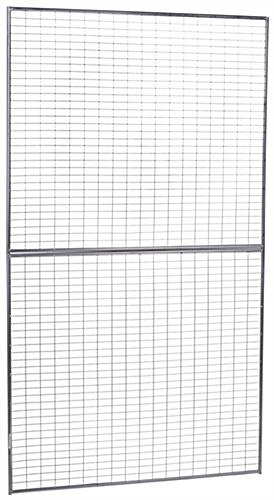Booth Display for 2-d Art
Although photography and paintings are the most common forms of 2-d art, it can be just about anything that hangs on a wall including fabric hangings such as quilts and ceramic or metal sculptures.
Racks and Panels
Mesh Rack
Generally, at art festivals, 2-d art is hung on racks. The Livermore Art Association (LAA) rents mesh style racks. These racks are approximately 3 ft x 6 ft, strong, hold up against wear and tear and are fairly light weight for their size but they are not very attractive. Another alternative is gridwall, which is better looking then the mesh racks and just as sturdy but heavy at over 20 pounds / panel. For more information on gridwall, visit the Grand+Benedicts site. An internet search can yield more information on alternate hanging systems and even provide information on how to make your own racks.
Gridwall
If you do use mesh racks, gridwall or any hanging system you can see through, consider using neutral colored back-drops behind the racks or covers on the racks themselves. Movement and color behind uncovered racks, people walking by, trees blowing, etc., can distract from the work itself. You can find covers to purchase via an internet search or if you or a friend are handy with a sewing machine, can be made from flat sheets or other materials. Lighter, neutral colors work best. Darker backdrops or covers can block light from getting into your booth space and make a small 10x10 ft space look cave like.
Picture Layout When Hanging
Consider the following when hanging pictures in your booth.
Artists Vera Lowdermilk and Liz Messer
- Limit how much work you bring to the show. Crowding work on a panel can take away the viewing enjoyment and individual impact a picture has on the viewer. Remember it isn't about how much work you bring but how well it is displayed that catches the viewers attention.
- Plan the layout of your booth, including panel and table placement at least a day before the show begins.
- Don't hang pictures haphazardly just to get them on the wall but consider color, tone, subject matter and contrast to create a cohesive display that attracts viewers. Map out picture placement before the morning of the show.
- Consider making prints of your work to introduce a new lower price point. Prints can be sold at a smaller size and /or as greeting cards.
Setting up a full 2-d display can be hot and heavy work. If you are doing show set up and tear down by yourself, consider using a smaller booth display rather then a full set up. For more information, see the descriptions of Kathy Hill's and Norma Webb's booth displays below.
2-D Booth Layout Examples
Below, some 2-d artists discuss their booth displays.
Tyler Thournir - Photographer
Although Tyler Thournir is a photographer and cinematographer who travels the world, his home base is the San Francisco Tri-Valley. The emphasis of Tyler's fine art photography work is travel and landscapes. Along with photography, Tyler also creates wedding and educational videos.
Tyler's booth display is open, allowing art patrons to take in his work at a glance. The white walls on the sides of his booth provide a backdrop for his work and separate his pictures from the rest of the show. Gridwall up front on the corners of his booth invite visitors in. A table shows off smaller prints and books and facilitates sales.
Tyler's Booth at Art Under the Oaks 2016
Close up of Tyler's booth display at Art Under the Oaks 2016
Jennie and Chuck McGregor - Photographers
Jennie and Chuck's Art on the Green 2015 booth display.
Jennie and Chuck McGregor are photographers specializing in photos of downtown Livermore, landscapes of the Tri-Valley and Northern California and in Jennie's case flowers and flower collages. Jennie is in charge of booth layout and for the most part, sales. Both Jennie and Chuck work on booth set up and tear down.
Jennie keeps booth layout as simple as possible with the majority of the booth consisting of covered gridwall and one 6 ft table to display small items and conduct sales from. Often times, there is a card spinner of greeting cards and a portfolio of larger packaged prints. Jennie introduces entry points into her display on as many sides as possible. She also likes to hang pictures on the outside of her tent, to provide a preview of what is under the canopy.
When selecting pictures for a show, Jennie considers the show audience. A show in Fremont next to San Francisco Bay, where they are restoring the shoreline, would yield photographs of wetlands, oceans and birds. A show in Livermore would include pictures of downtown Livermore and Tri-Valley landscapes. Although Jennie includes some flower photos in all of her shows, the Art Under the Oaks show at Alden Lane Nursery would emphasize flower pictures.
You can see more of Jennie's work at the Livermore Art Association Gallery.
Kathy Hill - Animal Portraitist
Well-known Tri-Valley artist and art show veteran Kathy Hill has over 25 years experience creating animal portraits. Although Kathy displays and sells her paintings at art festivals, they also allow her to opportunity to get commissions for portraits from pet lovers.
Kathy's show set up is minimal. She uses an umbrella as opposed to a canopy, uses a small table for business cards and a binder of pictures of her past work and a minimal number of racks, usually only using 3 racks. Kathy doesn't always use covers on her racks, but when she does, she uses covers she made from flat sheets. Kathy is also one of the few artists who demonstrates her painting while at the show.
Find out more about Kathy and the Art Under the Oaks show on our blog. Kathy studio is located in the Downtown Bothwell Studios.
Kathy's Display at Art Under the Oaks
Kathy Demonstrating Her Work
Kathy's Display at Art in the Vineyard
Norma Webb - Landscape Painter
Norma Webb is one of the best known landscape painters in the Tri-Valley. Her work centers on the grassy hills, ranches, vineyards and eucalyptus and oaks trees. Norma's work as been displayed at local galleries and shows through out the years.
Like Kathy Hill, Norma keeps her display set up simple, using an umbrella for shade, a small table to conduct business from and just a few racks to hang her framed work on. Her racks have neutral colored, handmade covers.
You can see more of Norma's work at the Livermore Art Association Gallery and the Blackhawk Gallery.
Norma Manning Her Booth
Norma's Booth











